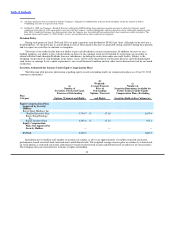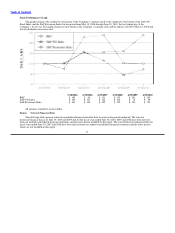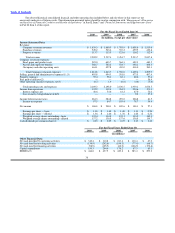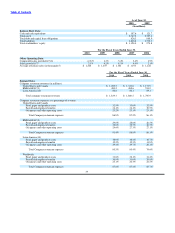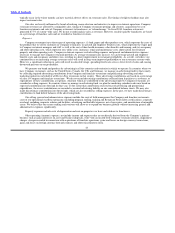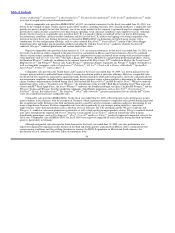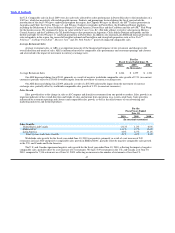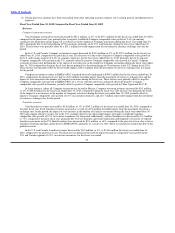Burger King 2010 Annual Report Download - page 45
Download and view the complete annual report
Please find page 45 of the 2010 Burger King annual report below. You can navigate through the pages in the report by either clicking on the pages listed below, or by using the keyword search tool below to find specific information within the annual report.
Table of Contents
typically occur in the winter months can have material adverse effects on restaurant sales. The timing of religious holidays may also
impact restaurant sales.
Our sales are heavily influenced by brand advertising, menu selection and initiatives to improve restaurant operations. Company
restaurant revenues are affected by comparable sales, timing of Company restaurant openings and closures, acquisitions by us of
franchise restaurants and sales of Company restaurants to franchisees, or “refranchisings.” In fiscal 2010, franchise restaurants
generated 87.7% of system−wide sales. We do not record franchise sales as revenues. However, royalties paid by franchisees are based
on a percentage of franchise sales and are recorded as franchise revenues.
Expenses
Company restaurants incur three types of operating expenses: (i) food, paper and other product costs, which represent the costs of
the products that we sell to customers in Company restaurants; (ii) payroll and employee benefits costs, which represent the wages paid
to Company restaurant managers and staff, as well as the cost of their health insurance, other benefits and training; and (iii) occupancy
and other operating costs, which represent rent, utility costs, insurance, repair and maintenance costs, depreciation for restaurant
property and other operating costs. Company restaurant expenses exclude selling expenses and general and administrative expenses
necessary to manage our Company restaurant portfolio. As average restaurant sales increase, we can leverage payroll and employee
benefits costs and occupancy and other costs, resulting in a direct improvement in restaurant profitability. As a result, we believe our
continued focus on increasing average restaurant sales will result in long−term improved profitability to our restaurants system−wide.
However, a significant reduction in sales will result in sales deleverage, spreading fixed costs across a lower level of sales and causing
downward pressure on our profitability.
We promote our brand and products by advertising in all the countries and territories in which we operate. In countries where we
have Company restaurants, such as the United States, Canada, the U.K. and Germany, we manage an advertising fund for that country
by collecting required advertising contributions from Company and franchise restaurants and purchasing advertising and other
marketing initiatives on behalf of all Burger King restaurants in that country. These advertising contributions are based on a percentage
of sales at Company and franchise restaurants. We do not record advertising contributions collected from franchisees as revenues, or
expenditures of these contributions as expenses. Amounts which are contributed to the advertising funds by Company restaurants are
recorded as selling expenses. In countries where we manage an advertising fund, we plan the marketing calendar in advance based on
expected contributions into the fund for that year. To the extent that contributions received exceed advertising and promotional
expenditures, the excess contributions are recorded as accrued advertising liability on our consolidated balance sheets. We may also
make discretionary contributions into these funds, which are also recorded as selling expenses. In the past, we have made discretionary
contributions to fund deficit balances of the advertising funds.
Our selling, general and administrative expenses include the costs of field management for Company and franchise restaurants;
costs of our operational excellence programs (including program staffing, training and Restaurant Food Safety certifications); corporate
overhead, including corporate salaries and facilities; advertising and bad debt expenses, net of recoveries; and amortization of intangible
assets. We believe that our current staffing and structure will allow us to expand our business globally without increasing general and
administrative expenses significantly.
Property expenses include costs of depreciation and rent on properties we lease and sublease to franchisees.
Other operating (income) expenses, net include income and expenses that are not directly derived from the Company’s primary
business such as gains and losses on asset and business disposals, write−offs associated with Company restaurant closures, impairment
charges, charges recorded in connection with acquisitions of franchise operations, gains and losses on foreign currency transactions,
gains and losses on foreign currency forward contracts and other miscellaneous items.
43





